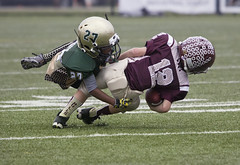Traumatic brain injury news reports and participation in high school tackle-football
Miles SH. JAMA Pediatr. 2018. [Epub
Ahead of Print].
participation coincides with an increase in news reports on football and brain
injuries.
The recent decline in adolescent boys
participating in American football may be influenced by media coverage of
football-associated health risks (concussions, chronic traumatic
encephalopathy). However, there is little data available to support this
notion. Therefore, the authors looked at football participation and news
coverage of football-related concussions from 2001 to 2016. The authors extracted football participation numbers from the National Federation of State High School Associations and news reports about traumatic brain injury and football from the LexisNexis Academic public database. The authors found
that from 2002-2008 there was a 9% increase in high school football participation;
however, from that point to 2016 there had been a ~5% decline in participation.
Additionally, the authors reported that
the number of news reports about football and brain injury was steady from 2001
to 2008, and then there was a marked increase in reports from 2009 to 2016. In
contrast to football, the overall participation in high school athletics for
adolescent boys is still increasing.
authors noticed that the timing of the shift from growth of high school
football to a decline coincided with an increase in the number of news reports
regarding American football and brain injury. While news coverage may be
related to the decline in football participation it had little impact on other
sports, in which participation rates continue to rise. We must use caution with
these findings because a correlation between increased news coverage and a
decline in football participation does not suggest that the news reports are
causing the decline. There may be other factors leading to this behavioral
shift such as a growing cost to athletes to participate in football or choosing
to participate in other popular sports such as lacrosse or soccer. It would be
fascinating to distinguish if this decline in participation led to a decline in
high school concussion rates. It would also be interesting to follow up with
high school students to determine if his/her decision to not participate in
football was due to concerns about head injuries. Future research should
further investigate the factors that are driving this behavioral shift away
from football participation. Recreational sports, including football, are
valuable strategies to promote physical activity. Hence, it is important for us
to understand the decline in high school football and its implications (e.g., are
athletes abandoning sports or switching to noncontact sports?). We also need to
better understand how the media portrays brain injuries in football and help
educate parents, athletes, and coaches when misinformation is provided. Currently,
medical professionals should continue to educate athletes on the risks and
mechanisms of a concussion, and ensure they understand that concussions can be
sustained in many sports, not just football.
school football? Do you believe athletes that do not choose to play football
are still participating in other contact sports?



Hi Jane,
Thanks for your review of this article. It is very interesting to see the trends of media coverage regarding concussions and football participation. I very much agree with the statement that correlation does not equal causation, as that is something that has been stressed to my classmates and I here at the University of Virginia. It will be interesting to see how the future of football plays out. I do feel that the media plays an important role in the beliefs/opinions of the sport, but the information they provide can sometimes be misleading.
Kyle,
I certainly agree that the media plays a role in the beliefs/opinions for many people.In my opinion the title can be the most misleading part of the article as click bait/draw people into reading the title. I would like to see more research on this topic to see if people who are reading the articles are changing behaviors in relation to sports/hobbies.
Hi Jane, thank you for sharing. I completely agree with you and Kyle that the media plays a massive role in the beliefs and actions of people regarding athletic participation. I think that the influence of the media on athletic participation has increased especially due to the recent release of concussion-related films, books, etc., which are most likely many individual’s first exposure to the injury and the extreme impact it can have on someone’s life and family. I believe there is a lot of fear in the sport of football now, and I have seen that mostly in the parents of young children who are considering participating in athletics. However, I have also met individuals who believe that concussions are not real injuries and that playing through them is fine. I think that more research needs to be done before the media can put out misleading extremes. I also agree that it is important to expose more research showing that other contact sports, including soccer and lacrosse, are also high risk for concussion.
Adrienne,
I agree with your point about the media and the need for extreme and catchy headlines. They tend to oversell and are well known for making the error that correlation do equate to causations, where we know that this is not the case. I would like to see more research done in this area. And, like you stated we need to continue to educate athletes that concussions are injuries to the brain (a vital organ) and they do need to be reported. An athlete with a sprained ankle would not last long trying to play with that injury, and they shouldn't play through the concussion symptom like dizziness and headaches.